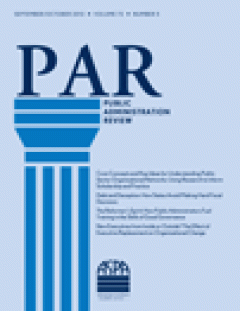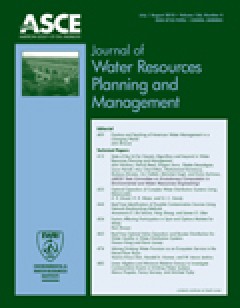Filter by

Performance Measurement in the Public Sector in England: Searching for the Go…
Despite the significant volume of studies on public sector performance measurement, a paucity of empirical research describes in detail the systems and processes used at different levels of government to measure and manage performance. This study focuses on the experience of Public Service Agreements in the public sector in England. In particular, the impact of a centralized, performance measur…
- Edition
- Volume 70, Issue 4, pages 591–600, July/August 201
- ISBN/ISSN
- 00333352
- Collation
- -
- Series Title
- Public Administration Review
- Call Number
- -

Ordering Stakeholder Relationships and Citizen Participation: Evidence from t…
Local administrative professionals typically are accountable to multiple stakeholders, including other governmental units, special interests in the business and nonprofit sectors, and citizens. How are these accountability relationships ordered? What is the position of citizens in that hierarchy, particularly the influence of citizen participation? Focusing on patterns of hearing participation …
- Edition
- Volume 70, Issue 4, pages 601–609, July/August 201
- ISBN/ISSN
- 00333352
- Collation
- -
- Series Title
- Public Administration Review
- Call Number
- -

Board Diversity, Stakeholder Representation, and Collaborative Performance in…
Does board diversity or representativeness influence organizational performance? Though it is understudied in both the public and the nonprofit sectors, learning more about this critical subject can enhance organizational performance within highly collaborative settings. Community mediation centers, which rely on multiple public and private resources to meet their programmatic objectives, provi…
- Edition
- Volume 70, Issue 4, pages 610–620, July/August 201
- ISBN/ISSN
- 00333352
- Collation
- -
- Series Title
- Public Administration Review
- Call Number
- -

Recovering, Restoring, and Renewing the Foundations of American Public Admini…
Public administration continues to face an identity crisis that turns on the question of whether the animating principles of the discipline are to be discovered in the political foundations of a given regime, or whether they are to be found in more universal and transcendent principles of scientific management. Herbert J. Storing reframed the identity crisis as a problem arising from America�s …
- Edition
- Volume 70, Issue 4, pages 621–633, July/August 201
- ISBN/ISSN
- 00333352
- Collation
- -
- Series Title
- Public Administration Review
- Call Number
- -

The global economic crisis, its gender and ethnic implications, and policy re…
The global financial crisis that began in 2008 has resulted in the widespread destruction of jobs and livelihoods. Among the factors that precipitated the crisis, growing inequality both within and between countries contributed to low levels of aggregate demand and the reliance of low-income households on unsustainable borrowing to maintain living standards. The crisis provides the opportunity …
- Edition
- Volume 18, Issue 2 July 2010 , pages 179 - 199
- ISBN/ISSN
- 13552074
- Collation
- -
- Series Title
- Gender & Development
- Call Number
- -

Gender and the global economic crisis in developing countries: a framework fo…
This paper sets out a framework for thinking about the gender dimensions of the economic crisis. It considers the likely impact of the crisis, as well as the responses to it, on the part of both individuals and collectivities, in three spheres of the economy: finance; production; and reproduction. It identifies the kinds of 'gender numbers' that we need; sex-disaggregated statistics of various …
- Edition
- Volume 18, Issue 2 July 2010 , pages 201 - 212
- ISBN/ISSN
- 13552074
- Collation
- -
- Series Title
- Gender & Development
- Call Number
- -

Critical times: gendered implications of the economic crisis for migrant work…
This article draws on the grassroots experiences and research of MAP Foundation to examine the gendered impacts of the economic downturn on migrants from Burma/Myanmar1 who are working in Thailand. The article looks through a gender lens at the wages, working conditions, family relations and safety and security issues. It finds that migrant women have experienced decreases in wages, lay-offs, i…
- Edition
- Volume 18, Issue 2 July 2010 , pages 213 - 227
- ISBN/ISSN
- 13552074
- Collation
- -
- Series Title
- Gender & Development
- Call Number
- -

Feminised recession: impact of the global financial crisis on women garment w…
This article discusses the findings of Oxfam-commissioned research into the impact of the economic crisis on women garment workers in the Philippines. It provides policy recommendations aiming to ensure that measures put in place by the government and international bodies support the women workers who have seen their jobs lost or their working conditions worsen, and ensure that recovery measure…
- Edition
- Volume 18, Issue 2 July 2010 , pages 229 - 240
- ISBN/ISSN
- 13552074
- Collation
- -
- Series Title
- Gender & Development
- Call Number
- -

Securing the fruits of their labours: the effect of the crisis on women farm …
Despite immediate promises of economic recovery by some Latin American governments, women in some regions of the continent are feeling the aftermath of the crisis deeply. This is because of both the interconnectedness of their regions to the export market, and pre-existing economic policies and social factors, including gender inequality that strengthens inequalities. These factors are intensif…
- Edition
- Volume 18, Issue 2 July 2010 , pages 241 - 247
- ISBN/ISSN
- 13552074
- Collation
- -
- Series Title
- Gender & Development
- Call Number
- -

Cheap and disposable? The impact of the global economic crisis on the migrati…
This paper investigates the impact of the global economic crisis on the migration of Ethiopian women domestic workers to the Gulf. It argues that migration as a strategy to cope with existing crises in Ethiopia will be severely constrained by post-downturn policy shifts, which have already produced a significant decline in numbers of recorded migrants and remittances. Evidence suggests the cons…
- Edition
- Volume 18, Issue 2 July 2010 , pages 249 - 262
- ISBN/ISSN
- 13552074
- Collation
- -
- Series Title
- Gender & Development
- Call Number
- -

The effects of the global economic crisis on women in the informal economy: r…
Findings from a recent study on the impact of the economic crisis on informal workers in Asia, Latin America and sub-Saharan Africa reveal that transmission of the crisis to the informal economy is hitting poor women hard. Women constitute the majority of the informal workforce in most developing countries, and predominate its poorest and most vulnerable ranks. Evidence from four informal secto…
- Edition
- Volume 18, Issue 2 July 2010 , pages 263 - 276
- ISBN/ISSN
- 13552074
- Collation
- -
- Series Title
- Gender & Development
- Call Number
- -

How the global economic crisis reaches marginalised workers: the case of stre…
This paper explores the effects of liberal macroeconomic policies and the economic crisis on informal street traders. Street traders are linked to financial markets and the crisis primarily though demand conditions: slower growth and over-trading translate into lower profits. Field research indicates that female traders' households rely significantly more than male traders' households on income…
- Edition
- Volume 18, Issue 2 July 2010 , pages 277 - 289
- ISBN/ISSN
- 13552074
- Collation
- -
- Series Title
- Gender & Development
- Call Number
- -

Crisis, care and childhood: the impact of economic crisis on care work in poo…
Caring for children and other dependents is crucial to human well-being, and to social and economic development. Yet, most national and international policymakers appear persistently blind to this fact, as has been highlighted by the recent global economic crisis. They need to recognise and value care work if they are to support vulnerable families from the effects of economic downturn. The 200…
- Edition
- Volume 18, Issue 2 July 2010 , pages 291 - 307
- ISBN/ISSN
- 13552074
- Collation
- -
- Series Title
- Gender & Development
- Call Number
- -

Optimal Design of Sensor Placement in Water Distribution Networks
In this study we provide a methodology for the optimal design of water sensor placement in water distribution networks. The optimization algorithm used is based on a simulation-optimization and a single-objective function approach which incorporates multiple factors used in the design of the system. In this sense the proposed model mimics a multiobjective approach and yields the final design wi…
- Edition
- Volume 136, Issue 1, Jan-Febr 2010.pp. 5-18
- ISBN/ISSN
- 07339496
- Collation
- -
- Series Title
- Journal of Water Resources Planning and Management
- Call Number
- -

Simulating Residential Water Demand with a Stochastic End-Use Model
A water demand end-use model was developed to predict water demand patterns with a small time scale (1 s) and small spatial scale (residence level). The end-use model is based on statistical information of users and end-uses: census data such as the number of people per household and their ages; the frequency of use; duration and flow per water-use event; occurrence over the day for different e…
- Edition
- Volume 136, Issue 1, January/February 2010. pp. 19
- ISBN/ISSN
- 07339496
- Collation
- -
- Series Title
- Journal of Water Resources Planning and Management
- Call Number
- -

Seasonal Residential Water Demand Forecasting for Census Tracts
The paucity of readily available demographic, economic, and water consumption data at household levels has limited the application of disaggregate water demand models. This research develops regression-based water demand models capable of forecasting single-family residential water demands within individual census tracts at a bimonthly time-step. The regression models are estimated using 12 yea…
- Edition
- Volume 136, Issue 1, January/February 2010. pp. 27
- ISBN/ISSN
- 07339496
- Collation
- -
- Series Title
- Journal of Water Resources Planning and Management
- Call Number
- -

Integrated Optimization of a Dual Quality Water and Wastewater System
When addressing urban water problems, it is no longer adequate to consider issues of water supply, demand, disposal, and reuse independently. Innovative water management strategies and opportunities for water reuse can only be properly evaluated in the context of their interactions with the broader water system. An integrated linear deterministic optimization model is applied to Beirut, Lebanon…
- Edition
- Volume 136, Issue 1, January/February 2010. pp. 37
- ISBN/ISSN
- 07339496
- Collation
- -
- Series Title
- Journal Water Resources Planning and Management
- Call Number
- -

Multiobjective Optimization of Operational Responses for Contaminant Flushing…
Contamination emergency in water distribution systems is a complex situation where optimal operation becomes important for public health. In case of emergency corrective operational actions for flushing the pollutant out of the network are needed, which have to be fast and accurate. Under such a stressful situation, trial-and-error simulation experiments with the hydrodynamic and water quality …
- Edition
- Volume 136, Issue 1, January/February 2010. pp. pp
- ISBN/ISSN
- 07339496
- Collation
- -
- Series Title
- Journal of Water Resources Planning and Management
- Call Number
- -

Large-Scale Nonlinear Conjunctive Use Optimization Problem: Decomposition Alg…
A cyclic storage (CS) system is defined as physically-integrated and operationally interconnected surface water and groundwater subsystems with full direct interactions between the subsystems. The proposed definition treats surface and subsurface impoundment subsystems as competing and potentially interconnected parallel storage facilities that minimize most of the problems associated with larg…
- Edition
- Volume 136, Issue 1, January/February 2010. pp. 59
- ISBN/ISSN
- 07339496
- Collation
- -
- Series Title
- Journal of Water Resources Planning and Management
- Call Number
- -

Water Use Intensities and the Composition of Production in Canada
The Government of Canada has endorsed a policy to promote water conservation in an attempt to reduce environmental impacts of water use. Nonetheless, total water intake, consumption, and gross water use in the business sector have increased in the period 1981�1996. Water intake intensities, measured in cubic meters of intake water per dollar of production, however, have fallen by 4%. To better …
- Edition
- Volume 136, Issue 1, January/February 2010. pp. 72
- ISBN/ISSN
- 07339496
- Collation
- -
- Series Title
- Journal of Water Resources Planning and Management
- Call Number
- -
 Computer Science, Information & General Works
Computer Science, Information & General Works  Philosophy & Psychology
Philosophy & Psychology  Religion
Religion  Social Sciences
Social Sciences  Language
Language  Pure Science
Pure Science  Applied Sciences
Applied Sciences  Art & Recreation
Art & Recreation  Literature
Literature  History & Geography
History & Geography